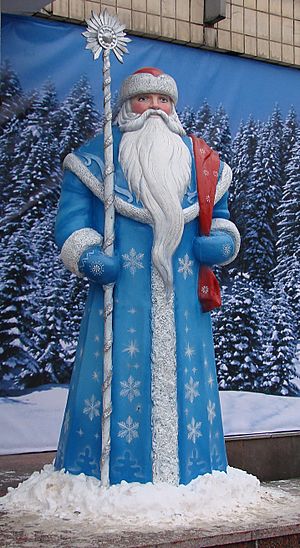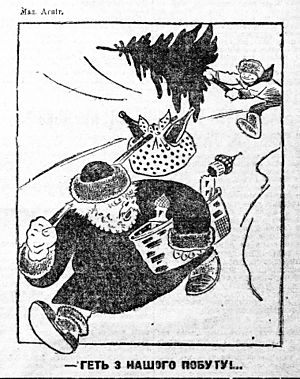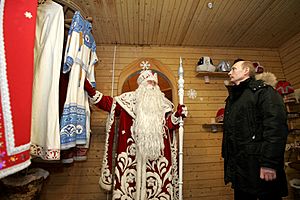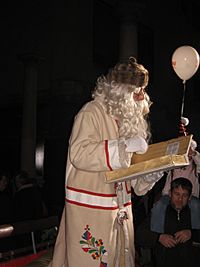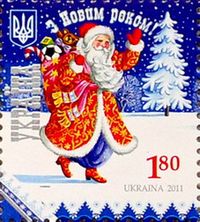Ded Moroz facts for kids
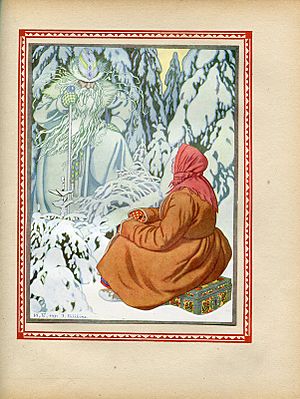
Ded Moroz (which means Grandfather Frost in Russian) is a legendary figure. He is similar to Saint Nicholas, Father Christmas, and Santa Claus. His story comes from old Slavic mythology.
Ded Moroz is very popular in East Slavic countries. He is a big part of Russian culture. For a time, during the early Soviet era, he was banned. But he soon became an important part of Soviet culture again.
Ded Moroz wears a long fur coat, usually red or blue. He has a round fur hat and special felt boots called valenki. He also has a long white beard. He walks with a long magic stick. Often, he travels in a troika, which is a sleigh pulled by three horses. He brings presents to well-behaved children. He often delivers them in person in December. Sometimes, he secretly leaves them under the New Year Tree on New Year's Eve.
His official home in Russia is the town of Veliky Ustyug. This town is in the Vologda Oblast region. In Belarus, his home is said to be in Belavezhskaya Pushcha.
In East Slavic cultures, Ded Moroz is not alone. He is joined by Snegurochka, his granddaughter and helper. Her name means "Snow Maiden." She wears long silver-blue robes and a furry cap or a crown shaped like a snowflake. Snegurochka is special because most similar characters in other cultures do not have a female helper.
Contents
How Ded Moroz Became Who He Is Today

The story of Ded Moroz began long before Christianity arrived in Russia. He was first known as a Slavic wizard of winter. Some old stories say he was a snow spirit or "snow demon." But back then, the word "demon" did not mean something evil. Over time, these old spirits were sometimes seen in a more negative way.
Later, the Orthodox traditions changed the character of Ded Moroz. In the 1800s, writers and plays helped shape his look and stories. A play called Snegurochka by Alexander Ostrovsky was very important. An opera based on this play by Nikolai Rimsky-Korsakov also added to his popularity. By the late 1800s, Ded Moroz was a well-loved character.
After the Russian Revolution, Christmas traditions were not encouraged. They were seen as old-fashioned and religious. In 1928, Ded Moroz was even called an "ally of the priest." However, Ded Moroz soon became very important again. He became the main symbol of the New Year's holiday, called Novy God, which replaced Christmas. Some Christmas traditions came back after a famous letter in 1935. This letter suggested that the New Year holiday was good for Soviet children.
Ded Moroz in Modern Russia
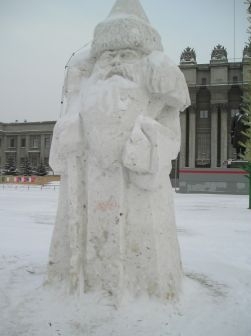
Ded Moroz is still very popular in Russia today. In 1998, the town of Veliky Ustyug was officially named the home of the Russian Ded Moroz. This was announced by Yury Luzhkov, who was the Mayor of Moscow at the time. Between 2003 and 2010, the post office in Veliky Ustyug received about 2 million letters for Ded Moroz. These letters came from all over Russia and the world. Even important leaders, like then-President Vladimir Putin, have visited Ded Moroz's home.
In the 1990s, Western culture became more common in Russia. The Western Santa Claus started to become popular. But in the early 2000s, Russia began to focus more on its own Slavic traditions. This included promoting Ded Moroz. The Russian government even sponsored courses about Ded Moroz and Snegurochka. These courses helped people learn how to play these roles for the New Year holiday. Now, people dressed as Ded Moroz and Snegurochka often visit children's parties. They give out presents and sometimes pretend to fight the wicked witch, Baba Yaga, who wants to steal the gifts.
In 2010, Ded Moroz was even considered as a possible mascot for the 2014 Winter Olympics in Sochi, Russia.
Other Names for Ded Moroz in Russia
Many different groups in Russia have their own names for Ded Moroz. For example, in the Bashkir language, he is called Qïš babay, which means "Winter Old Man." In Tatar, he is Qış Babay, with the same meaning. The Nenets people call him Yamal Iri, or "Grandfather of Yamal." The Yakut people have their own character called Chys Khaan, who is the "Master of Cold."
Ded Moroz and Other Santas
Ded Moroz often has friendly meetings with similar characters from other countries. These include the Estonian Santa Claus (Jõuluvana) and the Finnish Santa Claus (Joulupukki). They have one-on-one meetings, group meetings, and even friendly competitions. One example is the annual Santa Claus championships in Celle, Germany.
Tracking Ded Moroz with GLONASS
In 2009, Russia started its own way to track Ded Moroz. It's called GLONASS Tracks Ded Moroz. It uses GLONASS, which is Russia's own satellite navigation system, like GPS. This system is said to track Ded Moroz on New Year's Eve.
The website for GLONASS Tracks Ded Moroz lets you see where he is in "real-time." It also shares news about him throughout the year. You can send him an email, see photos and videos, and listen to Russian songs. It also has poems from children's letters to Ded Moroz. The site gives information about Veliky Ustyug, his hometown. You can also enter competitions and win prizes.
Ded Moroz in Other Countries
Ded Moroz and Snegurochka have equivalents in many countries that were once part of the former USSR or the Eastern Bloc. After the Dissolution of the Soviet Union, some countries wanted to bring back their own old traditions.
Armenia
In Armenian, Ded Moroz is called Dzmer Pap, which means "Grandfather Winter." His helper is Dzyunanushik, or "Snow Sweetie." This tradition came to Armenia when it joined Russia in the 1800s. Dzmer Pap and Dzyunanushik still look and act the same. They wear red, blue, or white winter coats. They bring gifts to children who sing songs or recite poems. They are a part of New Year and Christmas shows. Many families also invite them to their homes.
Azerbaijan
In Azerbaijani, Ded Moroz is Şaxta Baba ("Grandfather Frost"). His helper, Snegurochka, is Qar Qızı ("Snow Girl"). Even though Azerbaijan is mostly Muslim, this tradition is still very popular. Şaxta Baba brings gifts on New Year's. Qar Qızı is not as often seen at parties.
Belarus
In Belarusian, Ded Moroz is Dzied Maroz. He replaced the traditional Saint Nicholas during Soviet times. This was because Saint Nicholas had Christian roots. The official home of Dzied Maroz in Belarus is in Białowieża Forest.
Bulgaria
In Bulgaria, Santa Claus is called Dyado Koleda (Grandfather Koleda). Dyado Mraz (Grandfather Frost) was a similar character from Russia. He was popular during Communist rule because he wasn't religious. But since 1989, Dyado Koleda has become much more popular again.
Former Yugoslavia
In countries that were once part of Socialist Federal Republic of Yugoslavia, the gift-giver was called "Grandfather Frost" (Djeda Mraz in Bosnian/Croatian, Dedo Mraz in Macedonian, Deda Mraz in Serbian). He brought gifts for the New Year. This was because celebrating Christmas openly was not encouraged during communism.
In Croatia, after Yugoslavia broke up, Djed Mraz was sometimes seen as a communist symbol. Djed Božićnjak (Grandfather Christmas) was introduced instead. But now, Djed Mraz and Djed Božićnjak are often used to mean the same thing. In some families, Djed Mraz still brings gifts on New Year's. Children in Croatia also get gifts on December 6 from Sveti Nikola. He looks a lot like Djed Mraz. But he comes with Krampus, who takes away misbehaving children.
Kazakhstan and Kyrgyzstan
Ayaz Ata is the name for Ded Moroz in Kazakh and Kyrgyz.
Mongolia
Mongolia has celebrated New Year's as a holiday since Russian culture became common. "Өвлийн өвгөн" (Övliin Övgön), or Grandfather Winter, is the Mongolian version of Ded Moroz. He brings gifts to children and adults on New Year's Eve.
Romania
After Communists took power in Romania in 1948, Christmas was not celebrated. December 25 and 26 became workdays. A new character, Moş Gerilă (Old Man Frosty), was created. He was a Romanian version of Ded Moroz. He was said to bring gifts on December 31. After the Romanian Revolution of 1989, Moş Gerilă lost his popularity. Moş Crăciun (Father Christmas) returned.
Sakha Republic
Chys Khan is known as the master of cold here. He is joined by the snow maiden Khaarchana.
Slovenia
In Slovenia, Ded Moroz is called Dedek Mraz (Grandpa Frost). He is a slim man with a grey leather coat and a fur cap. This look was created in 1952. At first, he was said to live in Siberia. But later, his home was moved to Mt. Triglav, Slovenia's highest mountain. Public parades with Dedek Mraz started in 1953. He was important because he helped shift holiday celebrations away from religion and towards the secular New Year.
After communism ended in the 1990s, two other gift-givers returned. Miklavž (Saint Nicholas) brings gifts on December 6. Božiček (Christmas man, like Santa Claus) brings gifts on Christmas Eve. Slovenian families choose which gift-giver they prefer. Sometimes, the stories of Dedek Mraz, Saint Nicholas, and Santa Claus are mixed together. Dedek Mraz is still a public figure because he is not religious.
Tajikistan
In Tajikistan, the tradition of Ded Moroz continues. In Tajik, he is Boboi Barfi ("Grandfather Snow"). Snegurochka is called Barfak ("Snowball").
Ukraine
Since the breakup of the USSR, there has been a change in Ukraine. Many people now prefer Saint Nicholas (Sviatyi Mykolai) over Ded Moroz (Did Moroz). Saint Nicholas was more popular in Western Ukraine before. Some thought the government was discouraging Ded Moroz. But the Ukrainian Ministry of Culture said this was not true.
Uzbekistan
In 2012, Uzbekistan, a mostly Muslim country, moved away from celebrating Christmas and its characters.
See also
 In Spanish: Ded Moroz para niños
In Spanish: Ded Moroz para niños


